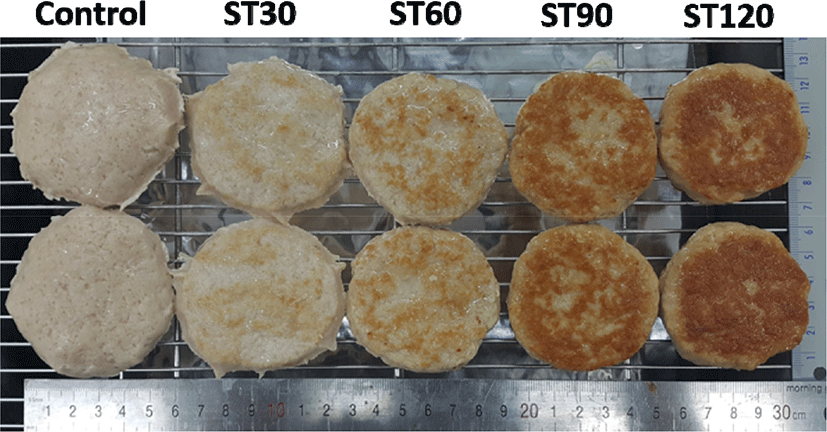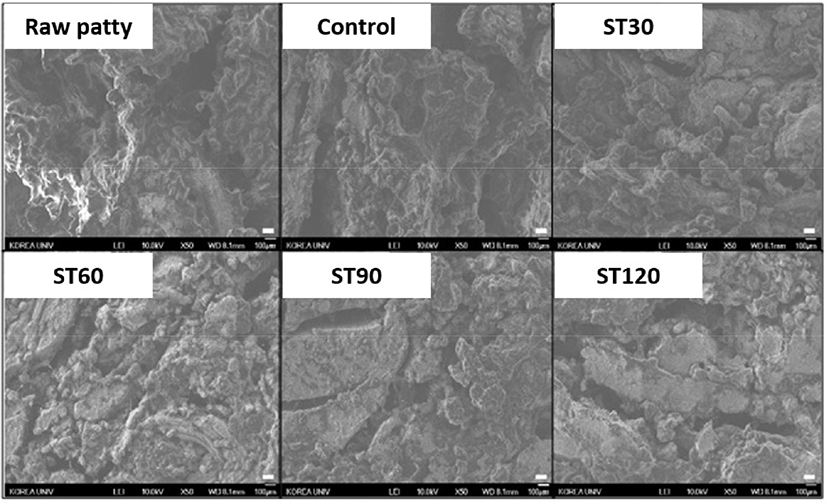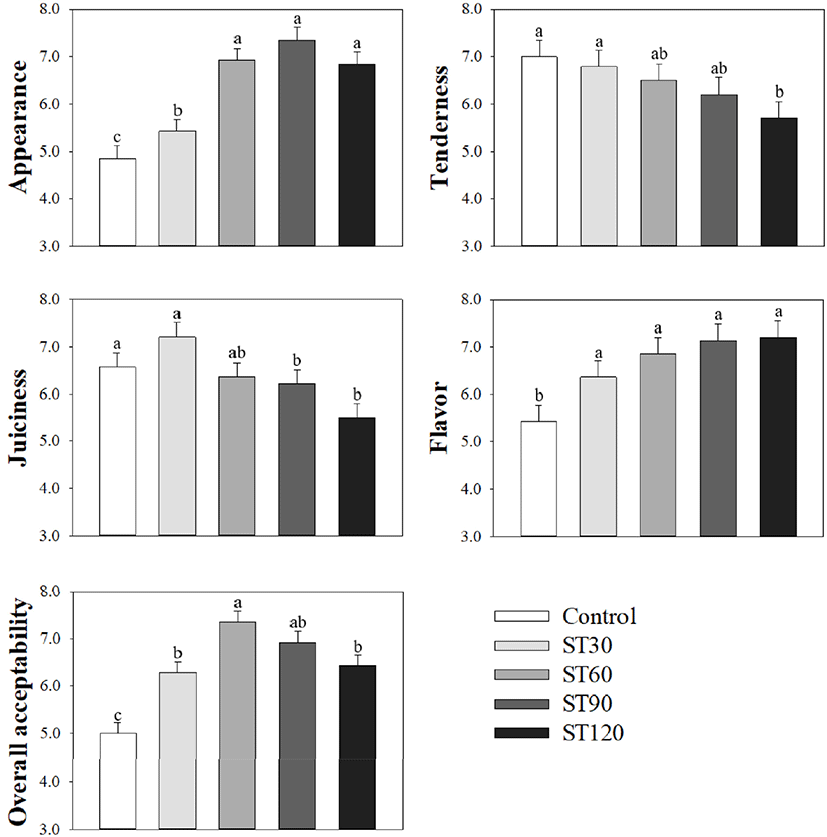Introduction
Aggregate meat demand per year has dramatically increased by almost 300%, and per capita consumption has also increased by approximately 230% from 1990 to 2018 (Korea Institute of Animal Products Quality Evaluation; KAPE, 2020), driven in part by population growth and economic development in Korea. Among the individual meat types, pork represents the highest per capita consumption compared to beef and poultry meat (KAPE, 2020). In quantitative preference surveys for specified quality attributes, Korean consumers still prefer pork portions containing high fat content such as pork belly and Boston butt (Oh and See, 2012; Vonada et al., 2000), even though they are usually trying to reduce their consumption of high fat foods (Choi et al., 2012). As a result, the total stock of pork cuts such as ham and loin has gradually increased (KAPE, 2020). In response, the meat industry has focused on developing and producing products with increased availability of these pork portions.
Recently, consumer preference is rapidly increasing for food products that are simpler and healthier due to changing the food-related lifestyle of consumers (Cho et al., 2020; Grunert, 2006). Additionally, fully or partially prepared foods can address the increasing demand for convenience of consumers, who lack the time and cooking skills to prepare food (Brunsø et al., 1995; Kim et al., 2018). Thus, the food industry has focused on the development and production of home meal replacements (HMRs) (Kim et al., 2018). Sous-vide (SV) cooked meat is one of the suitable food products that fulfill consumer needs for convenient ready-to-eat products since it exhibits desirable palatability and an extended shelf-life by inhibiting lipid oxidation and harmful bacterial growth (Baldwin, 2012). Particularly, this method as a low-temperature long-time is known to be effective in improving the tenderness of typically tough meat cuts by transferring heat uniformly and efficiently (Ruiz-Carrascal et al., 2019). These beneficial characteristics of SV cooked products are obtained through vacuum-sealed plastic pouches and precisely controlled heating conditions (Baldwin, 2012; Park et al., 2020). However, compared to meat products cooked by traditional cooking methods, SV cooked steaks and patties generally showed lower appearance acceptability and less flavor development (Cho et al., 2020; Ruiz-Carrascal et al., 2019). These are due to the lack of extremely high temperatures and less dehydration on the meat surface during SV cooking and are associated with a lack of occurrence of Maillard reaction (MR) (Dominguez-Hermandez et al., 2018). Thus, to improve drawback such as less development of surface color and flavor, which are disadvantages of SV cooked meat products, the addition of flavor compounds and searing process were recommended (Baldwin, 2012; Roldan et al., 2015).
Searing is a cooking method at high temperatures, such as pan-frying, grilling, and baking, until the surface is browned crust forms. Thus, searing meat products before or after SV treatment as an additional treatment can be used as an effective method to achieve the desired appearance and flavor of SV cooked meat steaks and patties (Dominguez-Hermandez et al., 2018; Ruiz-Carrascal et al., 2019). However, there is a lack of information about the effect of the searing treatment (ST) and the optimal conditions for improving the palatability of SV cooked pork patties. Therefore, this study investigated the effect of ST on quality characteristics, textural properties, and palatability of SV cooked pork loin patties to improve consumer preference and pork loin availability.
Materials and Methods
A total of 20 kg of fresh pork loin (5 kg per batch) and 4.4 kg of back-fat (1.1 kg per batch) were obtained from a local livestock vendor (Korea Prime Meat Industry, Seoul, Korea). Prior to pork loin patty production, meat quality measurements were conducted, and all porcine longissimus dorsi muscle used in this study were normal condition pork (42<lightness<50 and 2%<drip loss<6%; Choi et al., 2014). The pork patty formulation was 80% pork loin, 18.5% back-fat, and 1.5% salt, and visible connective tissue and fat were trimmed. Pork loin and fat were ground separately using a grinder with a 2 mm plate (Twin 275/114, Kutter-und Gerätebau Wetter GmbH, Biedenkopf, Germany), and then mixed for 3 min using a mixer (HL200, Hobart, Troy, MI, USA). A total of 95 patties per batch was produced four times using petri dishes to maintain a consistent weight (60±2 g) and size (70×15 mm). Pork loin patties were then wrapped with polyethylene film, and were stored at –20°C. After 24 h of frozen storage, the pork loin patties were vacuum-packed in single polyethylene bags with a vacuum packaging machine in a cold room (Leepack, Hanguk Electronic, Kyunggi-do, Korea), and immediately frozen at –20°C.
The frozen loin patties were thawed at 4°C for 5 h, and 19 patties per treatment were randomly selected (5 total treatments; 19 patties×5 treatments=95 patties). Before applying the SV cooking method, the ST treatment was performed on each side of pork patties by pan-frying (28 cm diameter, Cuchen, Cheonan, Korea) for 0 (control), 30 (ST30), 60 (ST60), 90 (ST90), or 120 s (ST120) at 180°C (5th heating level) using a cooking induction electric range (CIR-IH300RGL, Cuchen). In preparation for SV cooking, the pork loin patties were then vacuum-sealed in a polyethylene pouch (150×200 mm) using a vacuum packaging machine with a 98.81% vacuum degree (Chamber Vacuum Sealer System 300 Series, Polyscience Innovation Culinary Technology, Denver, CO, USA). A circulating temperature-controlled SV cooker (Fusionchef by Julabo, Seelbach, Germany) was used, and the cooking conditions for all pork patties were as follows: at 75°C for 120 min. After the SV cooking treatment, pictures of raw and SV cooked loin patties were taken (Fig. 1), and measurements of quality characteristics, cooking properties, texture profile analysis (TPA), and scanning electron microscopy (SEM) were performed using 10 samples per group. The remaining 9 samples per group were frozen at –20°C for sensory evaluations.

Sample pH was measured using a pH instrument with a penetration probe (Testo 206-pH2, Testo AG, Lenzkirch, Germany). The color values of SV-cooked loin patties, which were expressed according to the Commission Internationale de l’Eclairage (1978) lightness (L*), redness (a*), and yellowness (b*) values, were obtained using a Minolta colorimeter CR-400 (Minolta Camera, Osaka, Japan), and chromameter conditions were determined according to a previously published article (Lee et al., 2018). The mean values of three surface locations on each patty were used. The browning index was also calculated as follows (Roldan et al., 2015).
In order to measure the cooking properties of SV cooked loin patties, values for cooking loss, water retention, diameter reduction, thickness increment, and shrinkage percentages were calculated according to standard procedures (Cho et al., 2020; Murphy et al., 1975). SV cooked loin patties were cut into more than 8 cubes (20×20×15 mm) for TPA, and TPA was conducted using a texture analyzer (TMS-touch texture analyzer, Food Technology, Sterling, USA). SV cooked pork loin patties were compressed to 80% with a compression probe at a speed of 100 mm/min. The measured attributes included hardness, cohesiveness, springiness, chewiness, and gumminess using a previously described method (Bourne, 1978).
In preparation for SEM images, raw and SV cooked loin patties were freeze-dried for 24 h; then, the freeze-dried samples were coated with gold for 120 s at 20 mA using a sputter coater (Super Coater 108 auto, Cressington Scientific Instruments, Liverpool, UK). A scanning electron microscope (JSM-6701F, Jeio Tech., Seoul, Korea) operating at 10 kV was used to determine the microscopic morphology of the SV cooked loin patties.
Eleven panelists (six women and five men; 25 to 46 years old) were used and trained for at least six months according to the sensory evaluation procedure (American Meat Science Association, 1995; Meilgaard et al., 1991). Before panelist training and quality evaluations, human ethics approvals were granted by the Bioethics Committee of Kyungpook National University (protocol number: 2019-0027), and all evaluations were performed at Kyungpook National University. For the eating quality analysis, 180 SV cooked loin patties were used (9 samples×5 treatments×4 replicates) during 30 session. Six loin patties per session were thawed at 4°C for 5 h and were maintained at a core temperature of 54°C in a water bath before the evaluation. Trained panelists evaluated the sensory quality characteristics of the loin patties, which included appearance (very unacceptable to very acceptable), tenderness (very firm to very tender), juiciness (not to very juicy), flavor (flavorless to very intense flavor), and overall acceptability (very unacceptable to very acceptable), using a 9-point hedonic scale (1 to 9).
The general linear method procedure was used to compare quality, cooking, texture, and palatability characteristics among SV cooked loin patties with different STs (SAS software, 2014). Regarding these properties with the exception of palatability, a linear mixed model was used, and the model included searing temperatures as fixed effect and repetitions as random effect. For sensory quality characteristics, ST was included in the model as fixed effect and panels and repetitions as random effects. Significant differences in the least-square mean (LSM) of investigated parameters among treatments were observed by the probability difference option at p<0.05. The results for treatments were presented as LSM with SE.
Results
The effects of ST on quality characteristics and cooking properties among SV cooked pork loin patties are presented in Table 1. There was no difference in pH between the groups (p>0.05). However, a marked difference was detected in lightness among SV cooked loin patties; the ST120 group showed a lower value compared to the ST90 group (42.3 vs. 47.7, p<0.001). Redness value was similar between the control and ST30 groups (3.31 vs. 3.47, p>0.05), but a significant difference was observed in yellowness between the two groups (10.5 vs. 12.9, p<0.001). No difference was observed in yellowness between the ST90 and ST120 groups (17.4 vs. 18.2, p>0.05). Browning index values increased with the increase of ST times, and SV cooked loin patties with ST for 30 s exhibited a higher value compared to SV cooked loin patties without ST (26.6 vs. 20.8, p<0.001).
As expected, cooking loss was a lower in pork loin patties from the control group compared to patties from the ST groups (p<0.001). Moreover, the control group exhibited the highest percentage of water retention compared to the ST groups (p<0.001). Higher reduction in patty diameter after SV cooking was observed in the ST120 group compared to the ST90 group (21.3 vs. 19.0%, p<0.001), but no significant difference was detected in thickness increment between the two groups (22.4 vs. 21.7%, p>0.05). Total shrinkage of SV pork loin patties increased with the increase of ST times, and the control group showed the least change in size compared to the ST groups (p<0.001). The microstructures of raw and SV cooked pork loin patties are graphically presented in Fig. 2. As the ST times increased, the size of continuous gel structures comprising aggregated proteins and fat decreased in SV cooked loin patties.

A comparison of texture properties between the control and ST groups is shown in Table 2. Pork loin patties from the control group showed a lower hardness value compared patties from the ST30 and ST120 groups (3.59 vs. 5.30 and 6.67 N, p<0.001). Similar cohesiveness values were observed in the ST30 and ST90 groups (0.57 vs. 0.56, p>0.05), but a higher springiness value was detected in the ST90 group compared to the ST30 group (2.55 vs. 1.79 mm, p<0.001). The chewiness value was a higher in the ST90 group compared to the ST120 group (8.70 vs. 8.21 N · mm, p<0.001), although no difference was observed in gumminess among the ST60, ST90, and ST120 groups (3.49, 3.41, and 3.57 N, p>0.05, respectively).
Comparison of sensory quality attributes between groups conducted by trained panelists is presented in Fig. 3. Noticeable difference was detected in appearance acceptability between the control and ST groups, and the ST120 group scored higher compared to the ST30 group (6.85 vs. 5.43, p<0.001). There was no difference in tenderness between the control and ST90 groups (7.00 vs. 6.21, p>0.05), but the ST120 group had a lower score (5.71, p<0.05) compared to the control group. Similar juiciness score was detected between the control and ST30 groups (6.57 vs. 7.21, p>0.05). Samples from the control group received a lower flavor intensity score compared to samples from the ST groups (p<0.05), and there was no difference between the ST groups (p>0.05). Moreover, the control group exhibited a lower overall acceptability score compared to the ST groups (p<0.05), and similar scores were detected between the ST30 and ST120 groups (6.29 vs. 6.43, p>0.05).

Discussion
In the food industry, especially the restaurant and catering industry, SV processing is widely used to improve quality, uniformity, and storage stability (Baldwin, 2012). However, to improve the organoleptic characteristics of SV cooked meat patties, additional treatment is required. This study aimed to develop frozen SV pork loin patty as HMR that meets the demands of consumers, and searing processing was conducted before the SV cooking in order to improve quality characteristics, especially palatability, of SV pork loin patty. Due to additional heating treatment, lightness values decreased with increasing ST times, and patties from the ST groups showed a darker surface compared to patties from the control group (p<0.001). Marked difference between the groups was observed in the browning index (p<0.001), which is generally used as an indicator of browning in food products containing sugar (Roldan et al., 2015). As shown in Fig. 1, the extent of browning on the patty surface was a greater in the ST120 group compared to the other groups.
On the other hand, treatment yield gradually decreased with increasing treatment times (p<0.001). Significant difference was observed in shrinkage between the groups, and SV cooked loin patties from the ST120 group did exhibit the highest percentage compared to the other groups (p<0.001). Thus, additional heating treatments such as searing improve the quality characteristics and storage stability (Cho et al., 2020), but can decrease the product yield of SV cooked loin patties in this study. Generally, increased cooking conditions, including temperature and time, were accompanied by changes in cooking properties, and these properties were associated with water and fat loss due to increased denatured proteins and water evaporation (Alakali et al., 2010). Moreover, these changes influenced the texture properties of SV cooked pork loin patties. SV cooked patties with a higher cooking loss exhibited higher values of TPA-hardness and -chewiness compared to SV cooked patties with a lower cooking loss (p<0.05). Gumminess value was also a higher in the ST groups compared to the control group (p<0.001).
The importance of sensory quality improvement and quality control for product development of meat products, has been extensively reported (Imm et al., 2011; Lee et al., 2019; Yun et al., 2020). Among the organoleptic properties of meat products, the critical characteristics are tenderness, juiciness, and flavor, and their interaction is also important (Oh et al., 2019). Moreover, consumer purchase intentions are greatly influenced by overall appearance attributes, including color and appearance acceptability, when consumers consider purchasing meat and meat products (Nam et al., 2009). The use of the SV cooking method can lead to obtaining meat products with improved tenderness and juiciness and a reduced loss of nutritional values compared to traditional cooking methods (Baldwin, 2012; Park et al., 2020). In the current study, the searing process was additionally performed to overcome the poor appearance and flavor acceptability of SV cooked pork loin patties. The high temperature applied to the surface during the ST can promote the development of MR, and the MR is mainly associated with the development of surface browning in cooked meat patties (Dominguez-Hernandez et al., 2018; Roldan et al., 2015). In the present study, seared SV loin patties harboring a higher browning index level exhibited higher scores in appearance acceptability compared to the unseared SV patties harboring a lower browning index level (p<0.05), as consumers tend to recognize that underdeveloped brown surface coloring indicates that the meat uncooked or undercooked (Kieffer et al., 2000). However, no difference was observed in appearance acceptability among the ST60, ST90, and ST120 groups (p>0.05). On the other hand, due to increased dehydration through the additional treatment, SV loin patties from the ST120 group showed not only lower water retention percentage, but also lower juiciness and tenderness scores compared to patties from the control group (p<0.05). There were no differences in juiciness and tenderness scores between the control and ST60 groups (p>0.05).
Generally, the formation of desirable aromatic compounds that affect the flavor acceptability of cooked meat products increases with increasing cooking temperature (above 70°C) (Calkins and Hodgan, 2007). The browning index increased by the direct thermal treatment is an indicator for the development extent of MR products related to the flavor of food products (Ham et al., 2019). In the current study, marked difference was also detected in flavor intensity between the seared and unseared SV loin patties (p<0.05), and seared SV patties showing a higher value of browning index exhibited a better satisfying flavor compared to unseared patties with a lower value of browning index. Due to these results, a greater score of overall acceptability was observed in SV loin patties with searing compared to SV loin patties without searing (p<0.05). Especially, the ST60 group scored higher compared to the other groups (p<0.05), excluding the ST90 group (p>0.05). Overall, considering both cooking and sensory quality properties, searing the SV cooked pork loin patties for 60 s is the optimum treatment condition.
Conclusion
The ST for SV cooked pork loin patties can be a one of useful techniques for HMRs that can take combine the advantages of both the SV and conventional cooking methods to achieve a more appealing appearance and palatability characteristics as well as to enhance the availability of pork loin.













